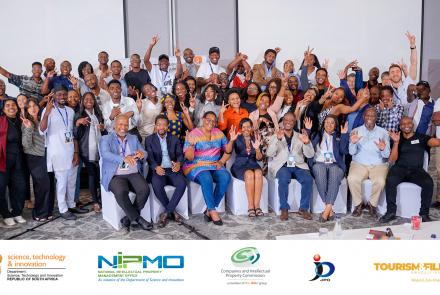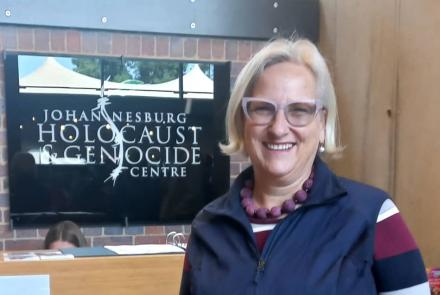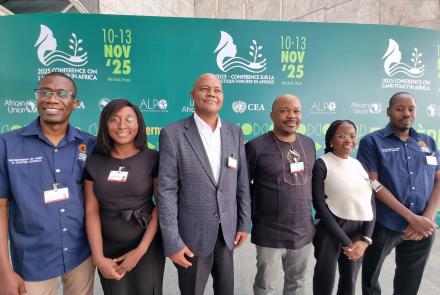Reflections on Research, Innovation and Partnerships at NUST
Neil deGrasse Tyson, an American astrophysicist, postulates that once you have an innovation culture, even those who are not scientists or engineers - poets, actors, journalists - embrace the meaning of being scientifically literate. They embrace the concept of an innovation culture. They vote in ways that promote it. They do not fight against science and technology.
This ethos speaks to the Namibia University of Science and Technology’s (NUST) approach to research, which falls under the portfolio of Dr Colin Stanley. He is the Acting Deputy Vice-Chancellor (DVC) for Research, Innovation and Partnerships. In this article, he reflects on the past, present and the future of these core areas.
A Brief History Lesson
NUST, as a premier science and technology university, is focused on fostering knowledge creation, applied research, innovation, and entrepreneurship. Simply put, research is applied everywhere - in communities, industries, and government, with the aim to solve social and economic challenges. This distinguishes NUST from conventional universities.
A bit of historical background to the birth of the Institution can enlighten this context of an applied university of science and technology. In Namibia's academic history, this was the country's first institution of higher education. It was called the "Academy for Tertiary Education" in the 1980s, and it had three branches: the university part, the College of Out-of-School Training (COST) for vocational training programmes, and Technikon Namibia for technical/applied programmes related to science and technology.
After Namibia's independence in 1990, the university branch was subsumed by the University of Namibia (UNAM), and the out-of-school branch was operationalised through Vocational Training Centres (VTC) around the country, under the Namibia Training Authority (NTA). The applied sciences and technology remained with the Polytechnic of Namibia (PoN). The PoN was transformed to NUST in 2015 and continues with the applied research. Some of the research output, e.g. conducted for mining companies, is proprietary to those companies, and not for peer-reviewed journals. This is what is meant by applied research. At times, the industry immediately puts the research output into practice.
The DRIP in the Research Veins
The Directorate of Research, Innovation and Partnerships, known as DRIP for short is headed by Dr Anna Matros-Goreses, the Executive Director. DRIP is mandated to enhance graduate outcomes and nurture stakeholder engagement and create an enabling impactful environment for staff and students to thrive. This is inclusive of technology and entrepreneurship development, as research, technology, and innovation are interdependent. They are linked and this is why they fall under one directorate.
Dr Stanley indicated that guided by the 2021-2025 Strategic Plan, the Directorate’s yearly plans outline what targets should be achieved each year in terms of the Institutional Operational Plan (IOP). “Amongst others, one target for us to accomplish this year is to increase international staff and students’ engagement in active research,” he said.
One of the NUST niche research thematic areas is the Food-Energy-Water Nexus. “This is key for us to contribute meaningfully towards poverty eradication. If you look at our National Statistics Agency (NSA), for example, they say that more than 50% of our people in Namibia cannot afford a balanced diet. They cannot afford a proper meal or three meals per day, or even if they can have these meals, the meal does not have proper nutrition. We need to solve these critical local issues," he emphasised.
He commented on the externally funded research project's progress thus far: "We have seen that our third-stream research income through research consultancy and grants income is gradually increasing.”
Re-engineering Services
While all revised strategic research-related policies and guidelines were approved by the Council last year, 2023, the Acting DVC noted that the focus for this year is to re-engineer/fine-tune research support service processes and automate them to create a conducive research environment. This he said, started last year when NUST onboarded the Open Researcher Contribution ID (ORCID) platform, which can be expanded with a front-end system to accurately report all research output automatically.
The focus is also on revamping research incentives. In recent years, researchers have been given seed funding from the Institutional Research Publication (IRPC) Budget. Furthermore, new funding categories will be introduced, such as postgraduate scholarships, conference attendance and journal publications. “Publications are perhaps one of the most outstanding indicators used to reflect research outputs. Hence, it is paramount to any research institution to evaluate the quality, validity, and originality of research, advance and recognise researchers in academia, secure research funding, and for international collaboration and visibility. For instance, the seed fund money can help emerging researchers conduct preliminary studies that requires data which they can use to get bigger grants,” Dr Stanley said.
He also emphasised that these full scholarships are also tailored to support research excellence in the Researcher Development Framework (RDF) approved by the Council last year in 2023. The scholarships will enable students to focus on their research without the financial pressures of supporting themselves through part-time work or other means. One of the conditions for this scholarship is that the beneficiaries must publish with their supervisor, thus leading to higher-quality research outcomes and contributing to advancing knowledge in their fields. Awardees must also complete their studies within the study period, contributing to higher graduation output, especially for PhDs. Moreover, based on the scope of studies of PhD programmes, more financial resources will be required for project implementation, including conference presentations by students as one of the outputs criteria of the scholarship.
Journal Accreditation
Another essential aspect to point out as prioritisation for this year is ensuring that NUST journals, such as the NAWA Journal of Language and Communication, get accredited. This process started last year when Digital Object Identifiers (DOIs) were assigned for all NAWA articles. The editorial guidelines for establishing any journal or publisher at NUST are also being formalised. “Another critical scholarly contribution we sometimes miss is the editors/reviewers who review and provide comments for our research papers to be accepted or refined. I am aware of Professors in the Department of Communication who are engaged in the editorial work for the NAWA Journal. We know that knowledge creation is done with other stakeholders. To enhance that knowledge and to test whether you have gathered the knowledge correctly, you will exchange your knowledge with others so that you can learn more. It is also proof that what you have learned makes sense when you can clearly transfer your knowledge to another person,” Dr Stanley remarked.
Strategic Partnerships
In the last year alone, there were over 30 industry partner negotiations under the High-Tech Transfer Plaza Select (HTTPS) in multiple sectors such as mining, logistics, local authorities, government, etc. Concerning university partnerships, the scope was widened to include the United States of America, amongst others. For instance, with the Old Dominion University (ODU), the University held an online seminar on Generative AI (e.g. ChatGPT) for educators and is now exploring research collaboration opportunities. With the University of South Alabama, collaboration on Technology and Research Parks is being explored, as well as joint grant applications for Research Administration and Management.
“We are cautious of the many partners we are onboarding. This year, we are prioritising adding only a few in strategic areas such as Green Hydrogen, Oil and Gas and working on cementing and nourishing our existing partners. Regarding university-industry partnerships, we take successes and challenges as lessons learnt for crafting best practices moving forward,” he added.
Research Ranking
This year NUST entered a collaboration partnership with the Times Higher Education (THE) which is a global platform where most reputable universities are ranked. The intention for NUST is twofold. Firstly, it is for the university to be ranked among other similar institutions on impact rankings against the United Nations' Sustainable Development Goals (SDGs) and the Sub-Saharan Africa University Rankings. Secondly, this allows us to use the data that we have gathered about our research activities to critically analyse where we are doing well, and where we are falling short. Moreover, THE will support NUST in achieving excellence in the overall impact of the institution's research and teaching efforts and developing brand messaging and reputation; nationally, regionally across Africa and globally. Overall, this collaboration enhances the University’s efforts to increase its visibility and research impact.
NUST is yet to be ranked by global platforms such as Quacquarelli Symonds (QS) World University Rankings or Shanghai Ranking, and there is always interest in the research community in knowing where the Institution is ranked and the area thereof. “We feature on many other platforms, for instance, NUST is ranked at number 44 in the top 200 universities by uniRank, but it is widely known that THE is one of the global platforms where everyone looks. There are different schools of thought on being ranked and whether it is impartial or not, but globally, your stakeholders, and your partners always look at global league tables.” he emphasised. Dr Stanley further underscored that it is not only the ranking that matters but it is for us to reflect on how impactful we are to our communities.
Innovative Product Development through Science and Technology Parks
The Institution has placed a lot of emphasis on innovation and product development to be able to yield products from research outputs. To accelerate innovation and product, the NUST Council in 2022 adopted the Science and Technology (technology + innovation = Technovation) Parks (STPs). STPs are specialised centres that support and promote technological development through research, innovation, and entrepreneurship that attract technology-based companies. Thus, an STP provides a conducive environment and ecosystem for research institutes, universities, and industries to innovate, conduct knowledge-based work, as well as research and development (R&D). The core goal of STPs at NUST is to improve industry competitiveness and boost regional economic and social development by applying specialised knowledge and R&D. HTTPS on NUST Windhoek's main campus and the famous Silicon Valley from the USA are excellent examples of STPs.
Dr Stanley said to fast-track the production of intellectual products: “The same way we recruit researchers, junior lecturers, lecturers, senior lecturers, we are also going to recruit junior researchers, researchers, and senior researchers, as per the Council approved RDF. So, that is one of the plans for this year.”
NUST Lüderitz Technovation Park: Powering Innovation and Fuelling the Future
Another significant focus for this year is the NUST Lüderitz Research Satellite Campus, which is already operational and will soon be officially launched. The strategic direction for the campus is to be research-focused, leading Namibia’s Science and Technovation Parks for Oil and Gas – the Blue and Green Economy. Moreover, the aim is for the Campus to be the anchor of the Science, Technology, and Innovation (STI) Ecosystem in the southern part of Namibia. The area is strategically located to tap into the raw economic prospects that the region presents. The south has been identified as one of the most ideal areas for green hydrogen production by Namibia’s Southern Corridor Development Initiative (SCDI).
“The purpose of research is to search and search again; to find gaps and make attempts to fill them. Innovation fills gaps that are found through research, and these days, it is challenging to innovate without technology, hence the coinage of the word 'technovation',” Dr Stanley concluded.






